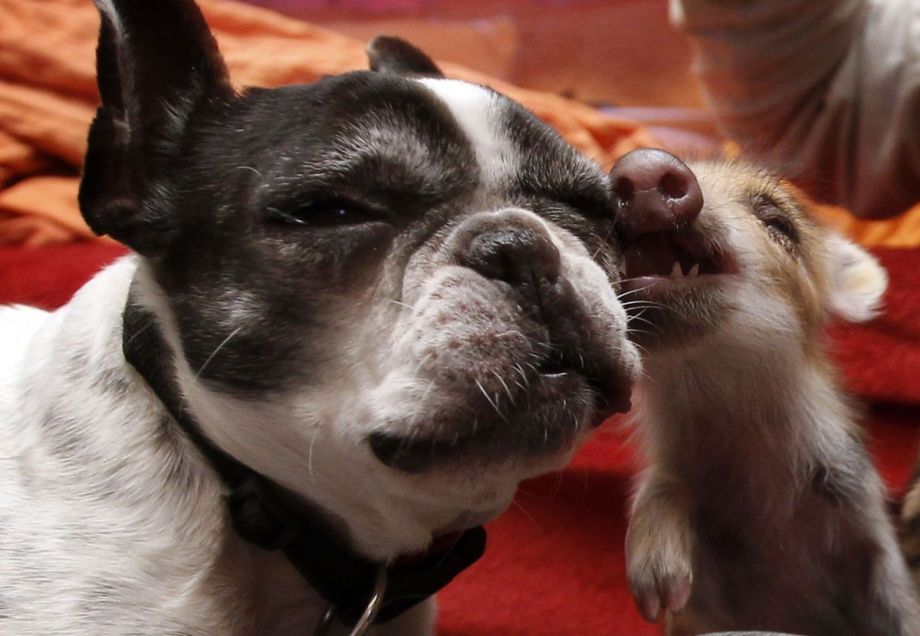As cities expand, it’s not just humans who are becoming increasingly urbanized. Concrete jungles and actual jungles are no longer realms apart, and as natural and human-created environments bleed into each other and intertwine, animals that walk on four legs, six or eight legs, fly or slither are calling cities home more and more.
In Feral Cities: Adventures With Animals in the Urban Jungle, released this month by Chicago Review Press, author Tristan Donovan finds that just like shifting from rural to urban living changed humans, city living is changing animals in sometimes surprising ways. At the same time, urban wildlife is changing the way some cities operate and use their resources. Here are just a few examples of that back and forth from the book and other recent research.
1. They Get Bigger.
For some animals, urban areas are all-you-can-eat buffets. There are bugs, garbage and prey animals to eat, and even humans who will feed you. Sometimes this means that animals eat better in the city than they do in “the wild.”
For example, Donovan says that gopher snakes in Paradise Valley, Arizona are consistently larger and in better shape than their country cousins because they have a steady supply of rats to eat. Meanwhile, in several towns around Lake Tahoe, urban bears pack on the pounds thanks to an abundance of trash and leftover food from humans and weigh almost a third more than rural ones.
2. They Follow the Rules of the Road.
Collisions with cars may be the biggest killer of Chicago’s estimated 2,000 coyotes, but many of them have learned a thing or two about navigating city streets safely. Scientists studying the animals as part of the Cook County Urban Coyote Research Project have found that they’ll sit patiently on the sides of roads and on street corners waiting for traffic to stop at a red light before trying to cross. They even seem to understand divided highways, and will watch only in the direction of oncoming traffic, without looking the other way. If there’s a median, they’ll dash across one section of the road and repeat the process.
3. They Downsize Their Homes.
Like a person who shares a place with four roommates so they can live in a great neighborhood downtown, some urban animals trade personal space for the convenience of the city.
In England, rural foxes have roughly a square mile of territory to themselves, but city foxes share that same size space with up to 14 other animals. Urban rabbits don’t have to share their space as much, but they have less space overall. A study in Germany found that rabbit burrows in the country are large, spread out and house many animals, like a rambling multi-family country estate, while city burrows are smaller, simpler, more evenly distributed and home to fewer individuals, like an underground complex of studio apartments.
4. They Change Their Schedules.
Some city animals will change their daily schedules to exploit urban resources or avoid conflict with humans.
In Bangkok, Thailand and New York City sparrows have become night owls, staying out later to feed because the bright lights around buildings draw plenty of insects. Urban bears around Lake Tahoe also work the night shift, eating and moving more after sunset so there’s less risk of bumping into people. In Germany, boars have adjusted their activities to humans’ schedules. During hunting season, the animals are known to commute from rural forest areas to the suburbs of Berlin during the weekend to avoid hunters, and then head back to the country during the week when the forests are safer.
5. They Move Around as Areas Gentrify.
Urban sparrows in London are drawn to old run-down homes with holes or nooks and crannies to build nests in. As neighborhoods change and old houses are renovated or torn down and replaced, their winged residents often have to fly off and find a section of the city that’s more accommodating.
In India, development is also leaving sparrows without an easy food source. In the past, the birds would pick at leftover bits of grain and vegetables as people cleaned and prepared food outside their home or at an open window. Now, more urban Indians have access to grocery stores and prepared and packaged foods, and sparrows have to fend for themselves more.
7. They’re Healthier.
With more resources and fewer predators, urban animals often have an easier life than their rural counterparts, and in several species that’s reflected in their mortality rates and health.
Chicago’s coyotes have an annual survival rate twice that of rural coyotes living outside of protected areas. Monkeys living in Jodhpur, India emerged largely unscathed from a severe drought in the early 2000s that cut rural populations by almost half. And while calling a rat clean is maybe going a bit overboard, city rats tend to carry fewer diseases and parasites than rural ones because, researchers think, they have less contact with livestock excrement from farms and their human neighbors don’t harbor many parasites.
8. They Get Bolder.
Routine exposure to humans lessens animals’ fear of us, and the occasional handout teaches them to associate us with food.
In Los Angeles, this led to some problems after people started leaving plates of food out for animals in Griffith Park. Some coyotes had gotten used to the free meals and would approach people in the park, nip them on the shin as a way of asking for some food (the same way they do with fellow coyotes), and then sit and wait for a handout. Eventually, three coyotes that had gotten too used to humans and free snacks had to be killed to prevent conflicts.
9. Architecture Becomes Weaponized.
Every year, Indianapolis sees an influx of starlings that Donovan says makes downtown feel like a scene out of Hitchcock’s The Birds. Starlings crowd into city parks and congregate all over buildings, leaving park benches, windows and sidewalks “slippery with waste.” The birds’ droppings are acidic enough to eat away at limestone and copper and carries diseases and parasites.
To protect public property and public health, some buildings in the city are outfitted with a number of tools to discourage the birds from hanging out on and around them. There are rooftop sound systems that blare starling distress calls to scare them away, plastic nets and electrified wires that prevent the birds from landing on ledges, and even a large balloon decorated with eyes that the starlings find terrifying.
10. Fire Departments Pick Up New Skills.
Forget the cat stuck in a tree. In Miami, the county fire rescue service deals with the city’s populations of exotic snakes and other reptiles. Moving into animal control made sense for them, says Donovan, because they were already up and running 24 hours a day and most citizens called 911 when they spotted a weird or scary animal. The service has its own internationally renowned venom response unit that’s equipped with the largest store of antivenoms in the U.S.
11. Cities Keep Hunting Squads on Call.
When the wild boars that roam Berlin get sick or injured, they can get very aggressive and lash out at people, which often means they need to be destroyed. Gunning down a several-hundred-pound boar on a busy street isn’t exactly easy, though, and the city police department is often reluctant to take on the task because of paperwork involved. So the city’s wildlife officer regularly calls on a volunteer force of Stadtjägers, or city hunters, to contend with the boars in exchange for any meat that’s fit to keep from the animals.
12. Some Go Dark or Build for the Birds.
Cities can be a great place for birds to live, but for those that are just passing through, they can be a death trap. Chicago happens to lie in the path of the Mississippi Flyway, a major north-south route for North America’s migratory birds, and the city’s lights can distract and attract them, leading to collisions with buildings.
In one night, there can be as many as 1,000 collisions at one building, according to Chicago Bird Collision Monitors. In response, Chicago and other cities on migratory routes have implemented “lights out” programs where buildings keep their lights off at night. Other cities, like Toronto, require that new construction implement certain “bird-safe” design aspects, like exterior lights that don’t point skyward and timers or motion sensors that switch interior lights off when the day is done.
Matt Soniak writes about science, history and Bruce Springsteen for a variety of outlets. His work has appeared in print and online for Mental Floss, The Week, Slate, Men’s Health, Scientific American, The Atlantic, ScienceNow and others. He lives in Philadelphia.












